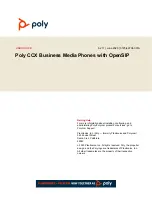
Due to the dynamic nature of the product design, the information contained in this document is subject to change without notice. Viking Electronics, and its affiliates and/or subsidiaries
assume no responsibility for errors and omissions contained in this information. Revisions of this document or new editions of it may be issued to incorporate such changes.
DOD# 218
Printed in the U.S.A.
P
P
r
r
o
o
d
d
u
u
c
c
t
t
S
S
u
u
p
p
p
p
o
o
r
r
t
t
L
L
i
i
n
n
e
e
.
.
.
.
.
.
7
7
1
1
5
5
.
.
3
3
8
8
6
6
.
.
8
8
6
6
6
6
6
6
F
F
a
a
x
x
B
B
a
a
c
c
k
k
L
L
i
i
n
n
e
e
.
.
.
.
.
.
7
7
1
1
5
5
.
.
3
3
8
8
6
6
.
.
4
4
3
3
4
4
5
5
O
O
p
p
t
t
i
i
o
o
n
n
s
s
ADA Compliant Emergency Phones with Built-In Digital Voice Announcer
ZF303290 Rev A
B. Central Station Operation
After the “
HELP
” / “
CALL
” button on the
1600A
Series phone has been pressed the
1600A
Series phone will begin to
dial. If a voice number is programmed in memory locations
#00-#04
, these numbers will be dialed first. Upon detect-
ing a busy signal or after a preprogrammed ring delay the
1600A
Series phone will hang-up and dial the central sta-
tion phone number stored in memory location
#05
. When the central station receiver answers, it will send a handshake
tone to the
1600A
phone. Upon detecting the handshake tone, the
1600A
Series phone will begin uploading the infor-
mation stored in memory location
#20
.
Once the
1600A
Series emergency phone has sent the information stored in memory location
#20
, it waits for a “kiss-
off” tone from the central station. When the “kiss-off” tone is received, the emergency phone turns on the call connect-
ed LED and goes into the “two-way talk mode” or hangs up and dials position
#06
if programmed (see Note 3 below).
Notes:
1.
The central station should have a “talk-over” feature that will allow a two-way conversation at this time. If your receiver does not support “talk-
over”, a voice phone number should be programmed into position
#06
.
2.
If the central station answers the call, sends the handshake tone, but does not send a “kiss off” tone after the information is sent, the
1600A
resends the information three additional times, waiting for a “kiss-off” after each attempt. If “kiss-off” has not been received after the fourth attempt,
the
1600A
hangs up and dials position
#05
again.
3.
The
1600A
has the capability to send a second informational message to the receiver after the first “kiss-off” is received, but only if a second
informational message is stored in memory location
#21
. After the first “kiss-off” is received, the
1600A
sends the information stored in memory loca-
tion
#21
. It then waits for a second “kiss-off” from the central station receiver. When the second “kiss-off” is received, the emergency phone turns on
the call connected LED and goes into the “two-way talk mode” or hangs up and dials position
#06
if programmed.
12
The
1600A Series
phones can be programmed to automatically deliver a digital announcement to identify the
location of the emergency call. Alternatively, a DTMF Touch Tone code may also be delivered. A “Call
Connected” LED can be initiated manually or automatically. All programming parameters, including phone num-
bers and location numbers, are stored in non-volatile memory. All units are phone line powered, requiring no
batteries or external power and are compatible with common Central Station Monitoring equipment.
For outdoor installations where the unit is exposed to precipitation or condensation, select
1600A Series
phones
are available with Enhanced Weather Protection (
EWP
). EWP products feature foam rubber gaskets and boots,
sealed connections, gel-filled butt connectors, as well as urethane or thermal plastic potted circuit boards with
internally sealed, field-adjustable trim pots and DIP switches for easy on-site programming. For more informa-
tion, see
DOD# 859
.
For more information on the
1600A Series
Emergency Phones, retrieve
DOD# 215
.
The
1600A Series
ADA Compliant Emergency Phones are
designed to provide quick and reliable handsfree communi-
cation for any standard analog telephone line or analog
phone system station port. All
1600A Series
phones
meet ADA requirements for elevator/ emergency tele-
phones, and can be programmed from any Touch
Tone phone. The phones can dial up to 5 pro-
grammable emergency numbers, as well as 2
central station numbers. In addition, the
E-
1600-20A
and
E-1600-52A
feature a second
"
INFO
" button that will dial up to 3 non-emer-
gency numbers.
E-1600-45A
K-1600-EHFA
E-1600A
E-1600-02A
E-1600-03B
E-1600-20A
E-1600-55A
E-1600-30A
E-1600-60A






























